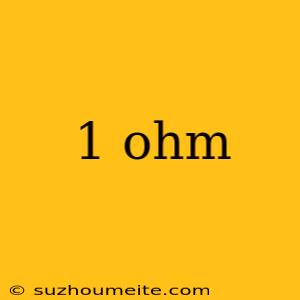1 Ohm: Understanding the Basic Unit of Electrical Resistance
What is 1 Ohm?
In the world of electricity, ohm is the SI unit of electrical resistance, and 1 ohm is the basic unit of measurement. It is defined as the resistance of a conductor in which a current of one ampere produces a voltage drop of one volt.
History of the Ohm
The ohm was named after the German physicist Georg Simon Ohm, who first described the relationship between voltage, current, and resistance in the early 19th century. Ohm's law, which states that voltage is equal to current multiplied by resistance (V=IR), is a fundamental principle in electricity.
What Does 1 Ohm Represent?
A resistance of 1 ohm represents the amount of opposition to the flow of electric current. In other words, it is the measure of how much a conductor opposes the flow of electric current. The higher the resistance, the more the conductor opposes the flow of current.
Practical Applications
Understanding 1 ohm is crucial in various fields, including:
Electronics
- Designing electronic circuits and devices
- Selecting components with specific resistance values
Electrical Engineering
- Calculating voltage drops and power losses in electrical systems
- Designing electrical transmission lines and distribution systems
Physics
- Studying the properties of materials and their electrical conductivity
- Understanding the behavior of electric currents in various materials
Conclusion
In conclusion, 1 ohm is a fundamental unit of measurement in electricity, representing the basic unit of electrical resistance. Understanding 1 ohm is essential in various fields, including electronics, electrical engineering, and physics. By grasping the concept of 1 ohm, individuals can better understand the principles of electricity and apply them in practical applications.
